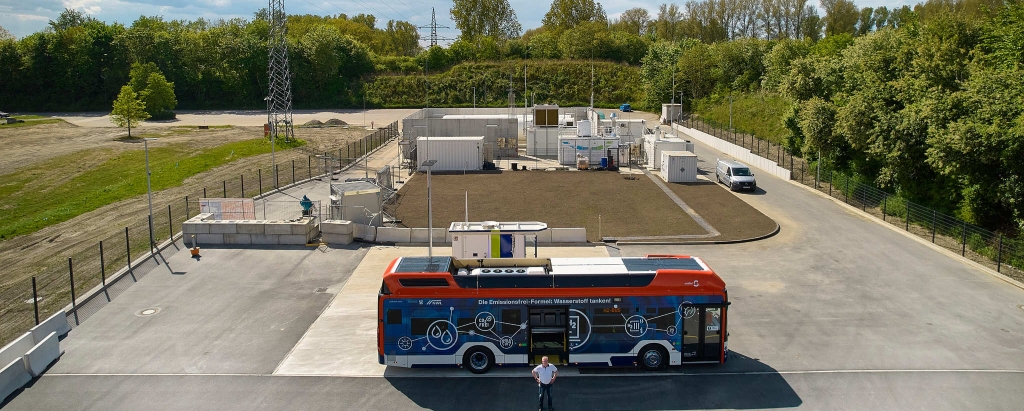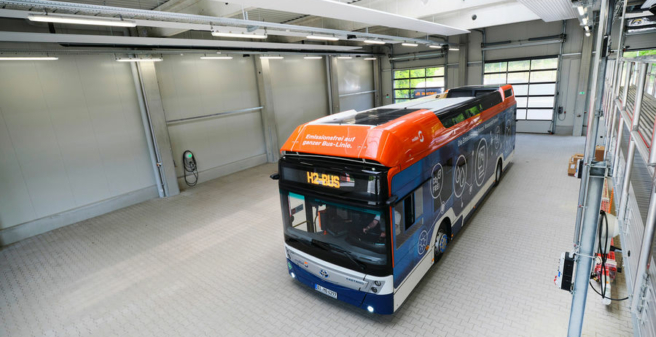
On 12 August 2023, Bielefeld’s municipal transport company “moBiel” invited people to an open day – a “Summer Party”. And a lot of people came.
While the event mainly took place at the Sieker depot, moBiel also offered an insight into the current status and its future plans in the bus sector at the “Innovation Park Sector Coupling”. And here especially in the field of hydrogen buses.
One of the four hydrogen buses that moBiel has been operating for two and a half years shuttled between the Sieker depot and the Innovation Park – i.e. one of the buses 6296 to 6299 of the “H 2 City Gold” model from the Portuguese manufacturer Caetano. The twelve-metre-long, two-door vehicles are fuelled with hydrogen and produce their own electricity in a fuel cell made by the Japanese car manufacturer Toyota. This is done by reacting hydrogen with oxygen in the air in the fuel cell, which produces electricity.
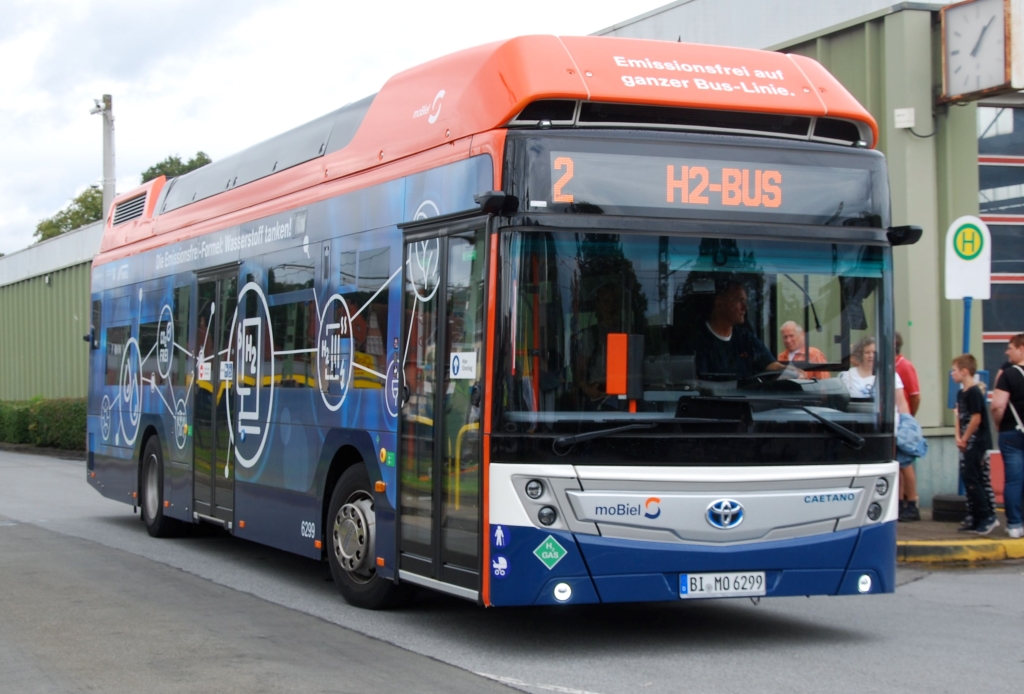
The Caetano H 2 City Gold
Let’s first take a closer look at the bus that was travelling between Sieker and Innovationspark (moBiel car 6299). The journey took about 15 minutes in each direction, half an hour there and back: time enough to get an impression of the coach while sitting on the seats of the German manufacturer Kiel. The bus appeared to be very cleanly finished, even after two and a half years absolutely nothing rattled. Like a little kitten, the car hummed quietly along. And it did so quite briskly, the driver enjoyed demonstrating the bus at “proper speed”. Visibly – or rather noticeably – the Caetano H 2 City Gold has rather soft suspension. This was not least evident when driving through bends at speed, where the car leaned slightly towards the outside of the bend – an effect familiar above all from the legendary Citroen 2 CV and the no less legendary Renault R 4. UTM reported on the Caetano H 2 City Gold at moBiel: https://www.urban-transport-magazine.com/en/hydrogen-in-bielefeld-the-new-h2-city-gold-buses/.
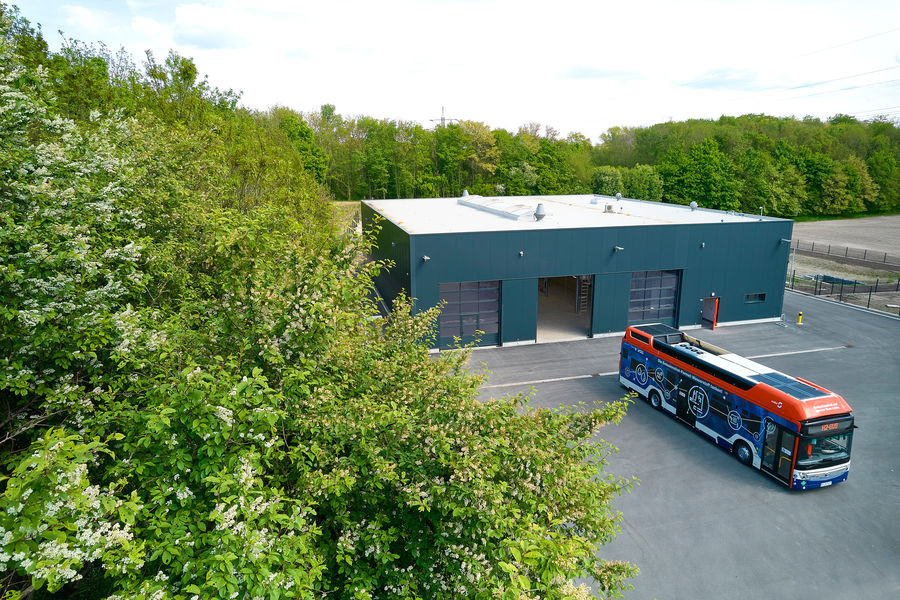
The “Innovationspark” depot
In the Innovation Park we got to know a very well equipped depot that moBiel has built especially for its hydrogen buses. They are here among themselves, and there are two reasons for this. Firstly, the hydrogen buses need facilities that the conventional (diesel) buses don’t need – more on that in a moment – and there wouldn’t have been enough space for that at the Sieker depot. And for another thing, it was possible to plan for the greatest possible safety here at the Innovation Park right from the start. The facility for only four hydrogen buses still seems rather large, but a tender for 25 more hydrogen buses, which are to be delivered in 2025, is currently underway. See also: https://www.urban-transport-magazine.com/en/more-funding-available-another-25-fuel-cell-buses-for-bielefeld/ .
With them, almost a third of Bielefeld’s bus fleet of currently 100 vehicles will already consist of hydrogen buses, and with them the plant will be much more heavily utilised. In addition, there is land in the neighbourhood where the depot can and should grow. Note: Project manager Sawatzky, who showed us around the depot, reported that the company will have 120 buses already in the foreseeable future. And another note: during the tour of the Innovationspark depot, there was also a single Mercedes Diesel Citaro in the hall. “That’s the reserve vehicle.”
The tour started with a talk by project manager Gerhard Sawatzky with a power point presentation on how a hydrogen bus works and how safe this depot is. For how a hydrogen bus works, see above: Hydrogen and the oxygen in the air react with each other to produce the electricity that is delivered to electric motors from Siemens and with which the bus runs purely electrically. And on the question of safety: the Innovationspark depot is very safe. The buses are parked at a distance from each other, so that if one of them should catch fire – which is no more likely than with any other vehicle – it won’t “infect” its neighbours. And what happens if hydrogen should escape into the parking hall? After all, you can neither see nor smell this gas, but it could lead to an explosion. Since it is lighter than air, it would immediately collect under the roof of the hall. And here, distributed across the hall, there are eight sensors that would immediately detect hydrogen and switch on fully automatic extraction fans that would release the hydrogen into the environment.
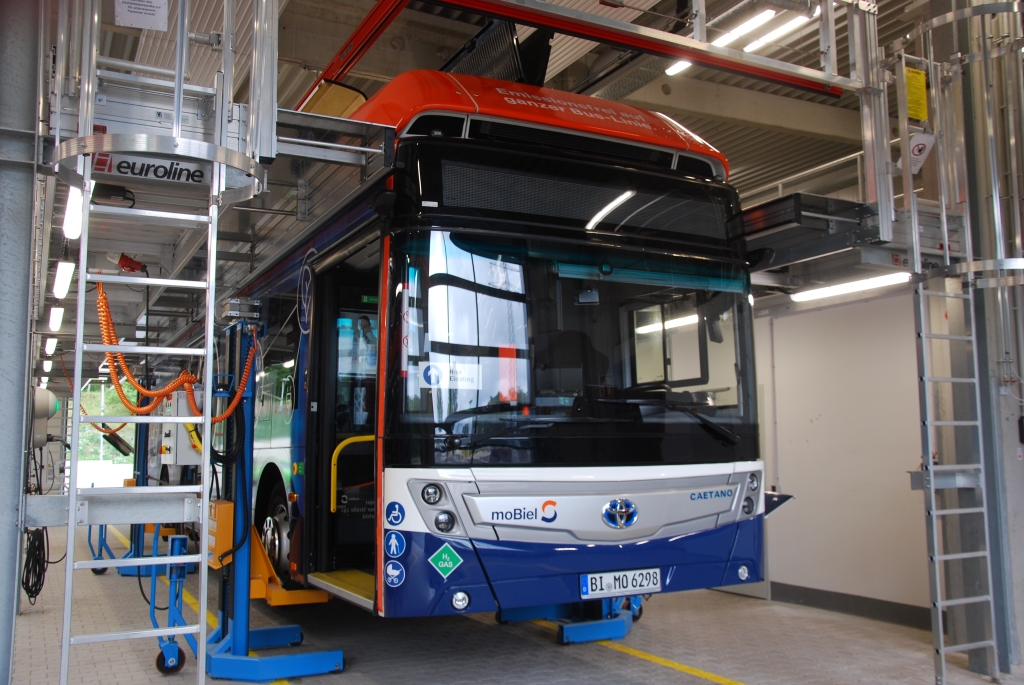
There is a workshop in the hall that is completely specialised in hydrogen buses. Not only can work be done here that is required for every bus, but above all this workshop is set up for the special requirements of a hydrogen bus. This is because there are so-called “roof workstations” here. The hydrogen buses have their specific technology on the roof: in addition to the air-conditioning system, there are three battery packs (manufactured by Forsee Power, capacity 44 kWh), five composite pressure cylinders for the hydrogen (in a diesel bus one would speak of a tank), fuelling capacity 37.5 kilograms, and above all the fuel cell from Toyota with an output of 60 kW. And all this can only be worked on from above.
Note: although moBiel is currently completely committed to the hydrogen bus, Sawatzky said during the tour of the depot: “The ranges of battery-electric buses have increased considerably in recent years. When they reach the point where a battery bus can run for a whole day without recharging – Bielefeld’s longest bus route covers 540 kilometres a day – then moBiel can well imagine procuring battery-electric buses.” Battery and hydrogen buses in parallel? Yes, yes, that is not at all unusual. Examples of this “double strategy” include Düsseldorf’s Rheinbahn, Frankfurt’s In-der-City-Bus and Mainzer Verkehrs Gesellschaft (MVG) – the new home for five of Wiesbaden’s ten hydrogen buses.
The presentation of the technology and the inside of the hall was followed by a tour of the outside of the depot. Here, the station where the hydrogen for the refuelling system is taken over was shown first. MoBiel obtains it from the chemical industry in the Ruhr area, and every ten days a haulage contractor delivers it with a tank semitrailer. Unloading this semitrailer takes two hours and works according to a simple physical principle: there is high pressure in the refuelling trailer, and lower pressure in moBiel’s tank facility. We know from physics that nature seeks to equalise pressure at different pressures: so the hydrogen flows from the tank trailer into moBiel’s fuelling facility.
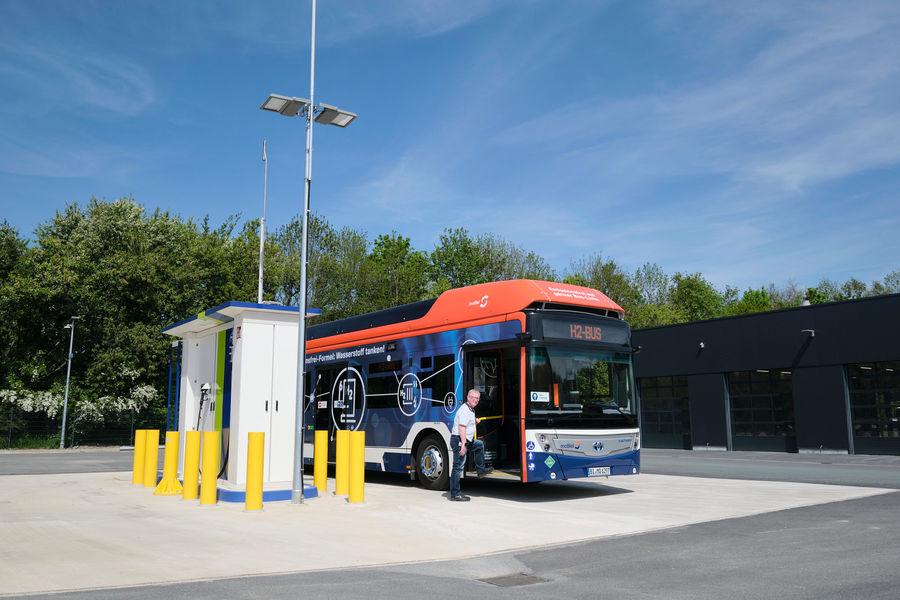
However, moBiel plans to produce its own hydrogen in the future with the help of the city’s waste incineration plant, which is located right next to the Innovationspark depot. Wuppertal’s WSW prove on a daily basis that this technique of producing hydrogen works splendidly.
In the tank facility, two large compressors generate high pressure again, and the hydrogen is also cooled here. Project manager Sawatztky answered the author’s comment “how wonderfully simple a diesel bus is” with the justified remark: “But the wonderfully simple diesel bus releases pollutants. The hydrogen bus drives pollutant-free.”
The refuelling process, or: a clear advantage of the hydrogen bus
The last stop on the tour was the actual refuelling station where the hydrogen buses take their hydrogen on board. When the bus’s tank is completely empty, it takes nine minutes to fill it up. That’s about the same time it takes to fill up a bus with a diesel engine. Sawatzky: “It takes several hours to fully charge the batteries of a battery bus. Imagine if you had to recharge the batteries of a hundred buses …”
